| 1 | The largest serpent venom yield |
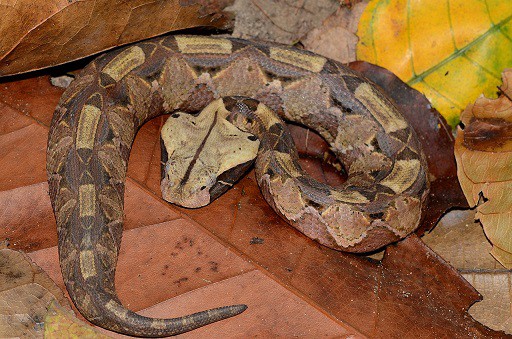
The gaboon adder (Bitis gabonica) is a venomous snake found in Africa, which is quietly the holder of several snake records. This is a thick-bodied brute of a snake which is common in central Africa, ranging from Nigeria in the west to Zimbabwe in the south, with a small pocket in South African Zululand.
Gaboon adders are a relative of the extremely lazy puff adder (Bitis arietans), and they fall into the lazy category themselves. This is a patient ambush predator which can wait for days in the same spot for oblivious prey to wander by. Gaboon adders have a lethal venom, but cause relatively few bites, as they shun human-inhabited areas.
The gaboon adder’s first claim to fame is having one of the world’s highest venom yields. Each strike injects 200-100mg, with another estimate being 200-600mg for a gaboon adder measuring 125-155cm. Either way, this drowns the French asp viper, with its average yield of 9-10mg.
In an experiment where scientists electrocuted a gaboon adder’s jaw using alligator clips (which somehow didn’t harm them), the total yield was over two grams (2400mg). A large capacity is one reason, but another is that gaboon adders hold onto their prey for many seconds, allowing more venom to be injected. By extrapolating from an experiment on monkeys, it was estimated that 14mg would be enough to kill a human being.
| 2 | The longest serpent fangs |
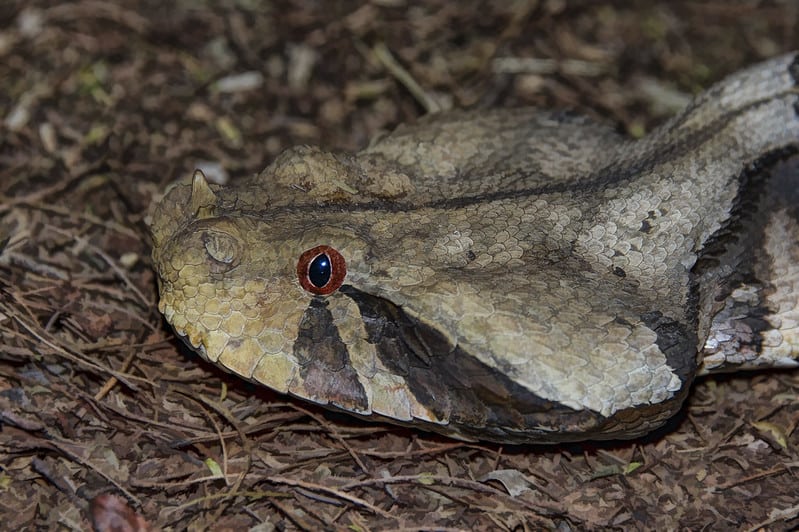
The gaboon viper holds an absolute world record for one snake feature, and it’s a lot more interesting than “brownest snake” or “quietest snake”. The gaboon viper is the snake among all 3900 with the longest fangs. These measure 2.2 inches (5.5cm), curve backwards, and fold into their mouth on flexible hinges. The tiger rattlesnake has fangs measuring just 4mm.
The gaboon viper’s giant snappers allow them to inject venom deeply into their rodent prey. At nearly 2 inches, another snake with massive fangs is the emerald tree boa, but this species is non-venomous.
The gaboon adder is a hefty snake, averaging at 1.5 metres, with an official record of 1.8 metres (and stories of 2.2 metre brutes still circulating). This is only 50% of the black mamba’s length, which has a record of 4 metres. Despite this, the gaboon adder is twice as heavy, mainly because the black mamba is as thin as a hosepipe. Gaboon adders weigh up to 25 pounds, and that makes them officially the heaviest venomous snake in Africa. They’re also significantly longer than their relative the puff adder (Bitis ariens), which averages at 100cm.
| 3 | Habitat: prefers bushy forest margins |
The gaboon adder is much fussier than its relative the puff adder, with a specific set of habitat requirements. You won’t find them on rocky slopes or dry savannah, but mainly forested areas interspersed with grasslands. In South Africa, they’re particularly common in coastal dune and coastal lowland forests. High rainfall is key for this snake. However, they’re not a true forest species, and usually avoid the dense interior (unlike a hairy bush viper). Instead, gaboon adders are attracted to thickets on the borders of forests, never straying in too deep.
This is perfect for several reasons. Firstly, their rodent prey lives there in abundance, and secondly, it provides endless alternating patches of sunlight and shade, where gaboon adders can bask in the sun or shelter at will. These thickets are sometimes deforested patches which are regenerating.
Next time you eat cashew nuts, remember that the farmers may have been leaping over gaboon adders to pick them, as that’s one of their confirmed dens in Uganda, along with tea and coffee plantations. However, they rarely enter sugar plantations, according to a study from South Africa. Gaboon adders also avoid shrubland and never appear in towns.
| 4 | Dangerous, but relatively calm |
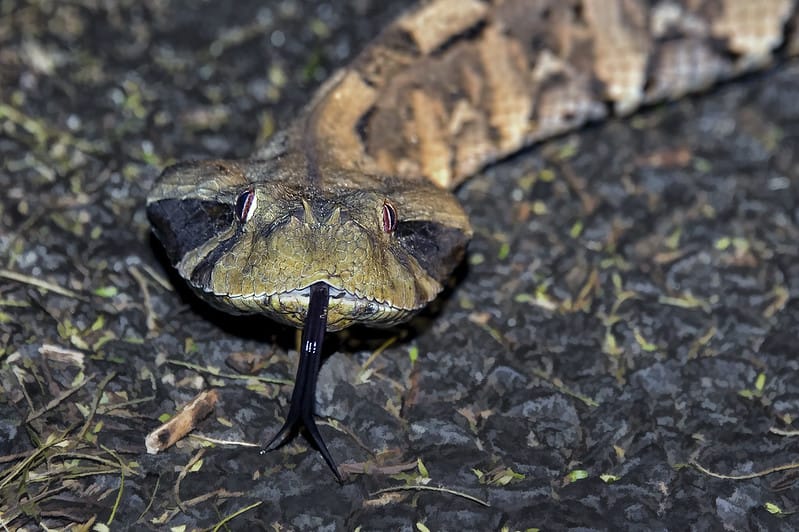
Their venom is corrosive and deadly, but gaboon vipers have one of the most benign reputations of venomous snakes. They apparently have no quarrel with the human race, with bites being rare. Unlike the twitchy black mamba, the gaboon viper is so relaxed that they won’t sink their fangs in even if you pick one up and stroke it lovingly (we still don’t recommend this). They rarely struggle even when researchers pick them up with steel tongs and store them in boxes.
The caveat to this calmness is that their strike, when it comes, is lightning fast. You might be unfortunate enough to step on one, or meet the bad-tempered bad egg of the gaboon viper world. Either way, their strike is virtually unavoidable, and the rapid speed is in extreme contrast to their slow slithering speed. Unlike the fast black mamba, gaboon vipers move at a snail’s pace, ploughing through the undergrowth patiently and unceasingly.
The main sign of agitation is a series of deep rumbling hisses, with each one flattening their head slightly.
| 5 | God-tier camouflage |
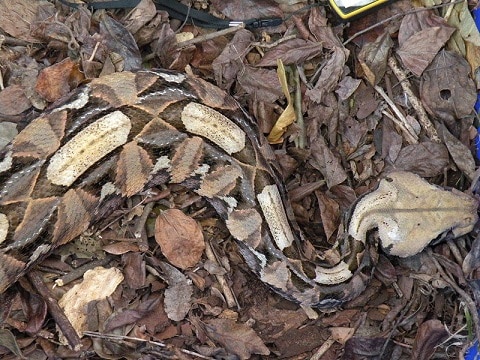
Like the puff adder, gaboon vipers have supreme camouflage, which is hard to see through even when you stare at a photo for 10 minutes.
Its patterns are complex, and resemble a rug on the floor of a mansion foyer. Their spine has a thick stripe which alternates between black and white like a set of dominoes. The sides have hourglasses in a brown, occasionally purple shape, sometimes with white and black at the centre representing the “sand”. The shades between the hourglasses are lighter, from from pale brown to yellow.
The gaboon adder’s belly is a purer yellow, but with black spots strewn around in random locations. Their eyes meanwhile, have a silvery tint. Most of the gaboon adder’s scales are keeled (rough) to touch, but they have a few rows which are smooth. Their other features include a dark spot above each side of the jaw, and a dark line down the centre of the head.
| 6 | Loyal to their home turf |
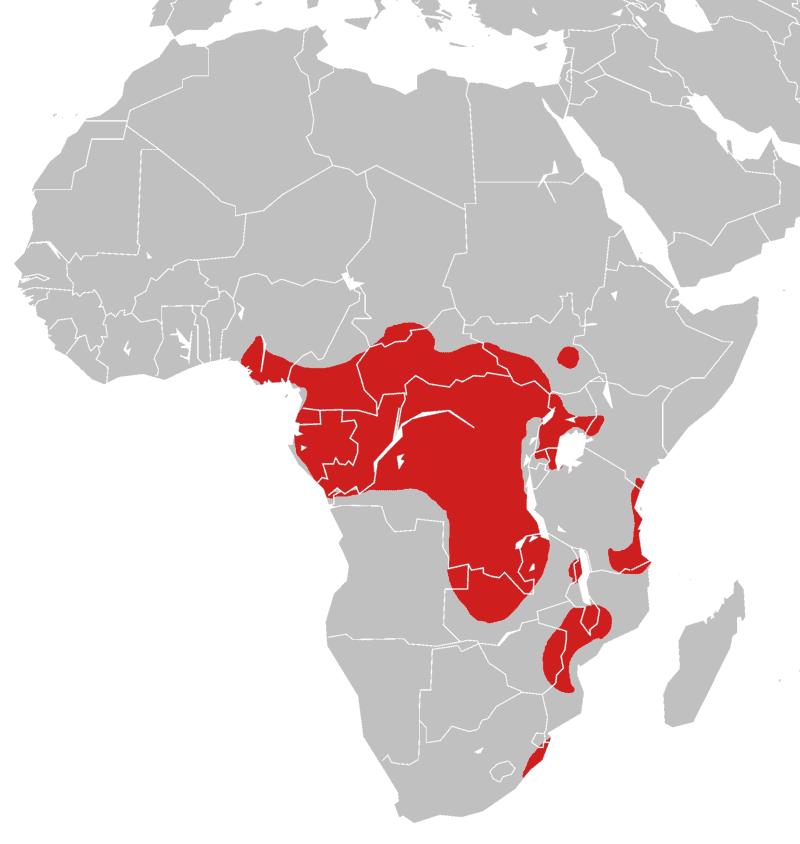
A study from KwalaZulu-Natal in South African tracked numerous gaboon adders, and found that they were stationary on 74.5-95.1% of days. Unlike the black mamba, they had no permanent shelters, like a personal rodent hole or crevice between fallen logs. But they were extremely loyal to their overall home range, living in a specific 1km patch their whole life which they rarely strayed from.
Gaboon adders move less than 10 metres per day on average, in the forest thickets they call home. However, they swing to opposite extremes. Sometimes, they’ll rev up and move 50-450 metres, while occasionally, they’ll barely move a muscle for 90 days.
In one study, scientists scooped up a gaboon adder and released it 2.5km south of its home territory. Almost immediately, the gaboon adder started slithering northwards. The scientists first re-observed it in a rural garden, and over the next few weeks, the gaboon adder slithered patiently through habitat it normally avoided, including sugarcane plantations and low grade grassland. The adder kept on moving, until 24 days after being dumped in a foreign land, it had reached its cosy home territory again. It achieved this using nothing other than inbuilt snake navigation.
Gaboon adders cope well with heat; they’re active on hot days when the sun beats down, but usually in the morning rather than midday.
| 7 | Diet: rock rats and grass mice |
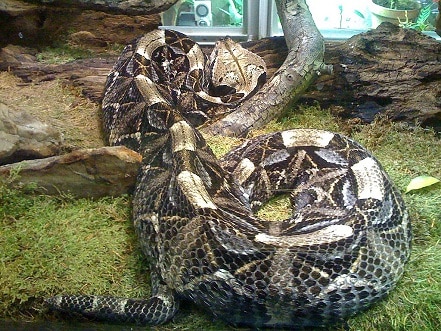
Almost all reports of this snake’s diet are mammals. In South Africa, their favourite prey includes vlei rats, the red veld rat, and the tree rat (Grammomys dolichurus), while their Nigerian staples include the giant rat (Cricetomys gambianus) and single-striped grass mouse. In 2003, a Nigerian study made things official, examining 524 wild gaboon vipers and finding mammals to overwhelmingly be the most common prey. More minor helpings included birds, lizards and occasionally frogs.
A 1999 study from Zululand in South Africa found a diet breakdown of small mammals (82.3%) and ground-dwelling birds (17.7%). The red veld rat (Aethomys chrysophilus) was easily their favourite prey, making up 19.8% of those identified. This widespread rat also favours forest thickets, bringing them into direct contact with gaboon adders. The favourite bird prey was the red-capped robin-chat, but this only made up 3.1% of meals.
Weirdly, shrews were plentiful in the forest studied, but the gaboon vipers ignored them. The red veld rat was the opposite; the snakes preyed on them in proportions far beyond their availability. When gaboon vipers from Zambia and Zimbabwe were examined, they too preyed heavily upon the Aethomys genus (collectively called rock rats), so they seem to be the nemesis of this family.
| 8 | Better at lurking than sprinting |
While not matching the crocodiles of African rock pythons, gaboon adders still have some hefty prey. One of the largest they’ve been recorded eating is the royal antelope. This is the world’s smallest antelope, and has a shoulder height of 25cm. It’s probably a good friend of Bambi, judging by its cuteness levels. The royal antelope mainly inhabits West African countries such as Ghana, Guinea, Liberia and Sierra Leone, and is extremely alert, fleeing quickly into the woods when approached.
Gaboon vipers also snack on the large-spotted genet. Overall though, they’re conservative snakes which shun belly-stretching meals; their average prey was 18% of their own body mass.
Gaboon adders are primarily an ambusher which lurks in wait, using thickets as disguise. With a crushing pounce, they leap onto their rodent prey, which has no time to react. After biting and injecting venom, gaboon adders always hold onto their prey while it succumbs.
A relaxed gaboon viper will be loose and floppy, but one preparing to hunt will have its neck coiled tightly like a spring, in preparation to strike like the crafty viper they are. Gaboon vipers often position themselves adjacent to trails forged by deer, which smaller rodents then take advantage of, not anticipating the danger lurking.
| 9 | Mimicked by a local toad |
The gaboon adder has an admirer in the amphibian world which is riding off its existence for survival – the Congolese giant toad. This toad is a brute which measures 12-15cm, and has a beige colour which blends perfectly into parched leaves. But when seen from a bird’s eye view, something else becomes clear – this toad’s entire body is mimicking the gaboon adder’s triangular head.
The colour is close, there’s a similar line down the centre, and the shapes are so similar they would slot together in a rack. The toad’s back also possessed two black spots, which were too similar to the gaboon adder’s head to have been coincidental.
When the toad was monitored in a 10 year study, that it was mimicking the gaboon adder became undeniable. When confronted by predators, the toad folded its front legs forward in a “bow” manoeuvre, hiding the one body part that could expose the ruse. The toads also copied the gaboon viper’s deep hiss, by releasing a puff of air like a balloon. The study even found that in 11 areas of the Democratic Republic of Congo where gaboon adders were missing, the toad was also absent.
| 10 | Chest tightness and heart pain |
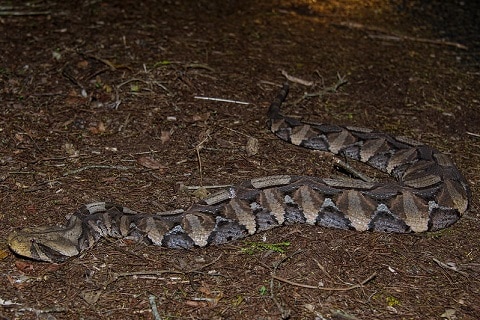
The gaboon viper has a wider spectrum of eye movements than other snakes. Its eyes are on the sides of their heads (rather than facing forwards), and one eye can face forward while the other faces backwards.
Despite resting motionless in ambush, their eyes commonly jerk back and forth in a restless manner. When the gaboon viper sleeps, its pupils contract to a dot, and the jerky eye movements stop. The moment they awaken, the pupils suddenly dilate, ready for action (which is actually inaction).
Gaboon viper venom attacks the heart, going for every organism’s ultimate weak point, the effective engine of all human beings. Chest tightness is a common symptom from bites. Overall, gaboon vipers aren’t known for their neurotoxins (unlike black mambas). They spare the brain, but cause necrosis, massive swelling and anticoagulation, the disabling of clotting, often causing blood to pour from the bite wound. Amputation is a risk for gaboon adder bites. While deaths are rare, one reptile keeper died after being bitten by his pet gaboon adder.
